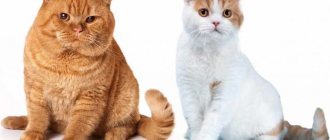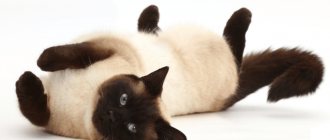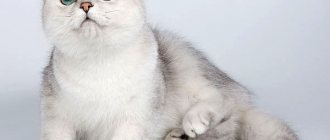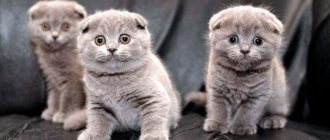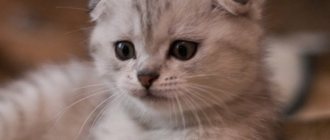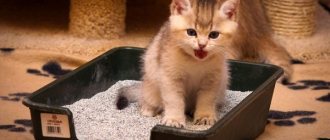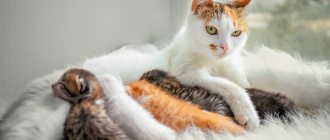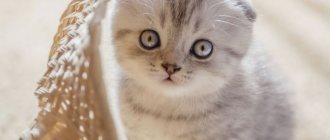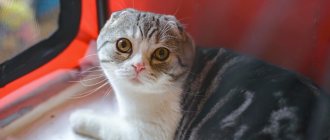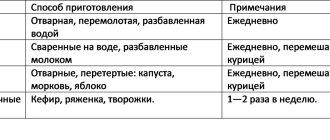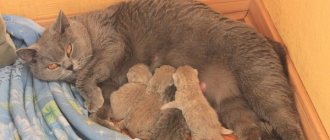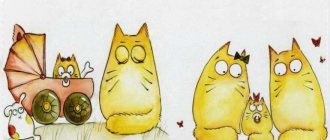Folding ears are associated with the specific structure of the ears. This property was recorded in Scotland in 1961, when breeders began to deliberately breed lop-eared kittens. Hence the second name of this breed – Scottish.
Scientists have discovered that this ear structure is a gene mutation, with lop ears being a dominant gene. When two fold-eared cats are crossed, weak kittens are born. In order for the offspring to be healthy, one parent must have fold ears, and the other must have straight ears. When purchasing, find out which cats your future pet comes from. This will save you from choosing a purebred but sick kitten.
Newborn fold kittens
Kittens in a litter from a fold-eared parent and a straight-eared parent are different, but they can be distinguished from each other after 2-3 weeks.
British and Scottish ears
Important! It is recommended to buy a fold kitten when it is 6 weeks old. At earlier stages, you risk paying a large sum and finding that the kitten's ears will straighten over time.
Straights and folds
The Scottish Fold cat breed, characterized by ears with an abnormal structure, became known in the first half of the 60s of the 20th century.
It appeared a little earlier, but did not immediately deserve the attention of scientists. In the 60s Thanks to scientific research, it was found that lop ears appear due to a gene mutation.
By crossing two identically fold-eared individuals, as scientific experiments have shown, it is almost impossible to get healthy kittens with the same unusual ears. The offspring are weak, non-viable, and have many genetic defects.
To get a healthy Scottish Fold kitten, breeders resort to tricks. They cross a fold-eared individual (Scottish Fold) with a straight-eared Scot (Scottish Straight). These breeds are considered related, but at the same time they are independent. The offspring from such a union turns out strong and healthy.
The birth of a viable kitten that meets the standards of the Scottish Fold breed is possible if its parents have the following characteristics:
Why is September a healthy and happy month for cats? Why does a cat bang its head against you in the evenings? 5 “exotics” that are best not to have at home What should you do if your cat sleeps with its eyes open?
- flexibility of the tail (the key to a healthy spine);
- uniformity of color, which should be the same in females and males;
- having ear folds.
The offspring born from the “correct” parents can either have the ear structure typical of Scottish Folds or be straight-eared, like Scottish Straights. It is not possible to determine this in the first weeks of a baby’s life. Fold does not appear until kittens reach three weeks of age. The ears of straights and folds at this stage of development have the same appearance.
This is interesting: Do cats grow whiskers?
Character and habits of the Scottish Fold
Scottish Folds are simply created for life in a large family. They are very sociable and playful. They love to involve all family members in their games. Scottish cats are very sociable and get along well with children and the elderly. They allow children to cuddle themselves and play with them with pleasure. As for the character of each individual, like people, it is individual; some associate the color of an animal with certain character traits.
For example, it is believed that blue Scots, due to their British genes, have a more quarrelsome character, and on the contrary, bicolors are considered cats with a soft and good-natured character. However, each animal is individual in one way or another. Some Scots do not leave the hands of the owner and strive to be close to the owner, while others, on the contrary, do not let anyone near them.
Interesting fact: Handsome adult lop-eared cats can easily tolerate loneliness and can sleep all day or occupy themselves on their own. However, if the animal wants attention or gets hungry, it will definitely let you know about it with its loud “meow”.
The Scots also have such character traits as stubbornness and willfulness. Often expressed in whims and a desire to be the center of attention. Although these cats can be trained well. At the genetic level, cats of this breed have certain beautiful manners. The Scots are well accustomed to the litter box, they recognize the scratching post and do not damage the furniture; they behave quite decently and decently.
Even if the cat is offended by something, he will not take revenge. The Scots never steal food, they can eat from the table or from the pots, but they never hide, but eat calmly and openly, with the dignity of kings.
External signs of lop ears
A fold-eared kitten has structural features of the entire body, and not just the ears. These include:
- The nose is without humps, which can be determined by touch.
- The tail is smooth, without humps or knots.
- Wide muzzle.
- Round head.
- Small cheeks.
- Wide eye set.
- Large chest.
- The legs and tail are shorter and larger than those of their straight-eared counterparts.
- Plush wool.
External signs of fold-eared cats
Interesting! Fold cats are long-haired - Highland Folds, and short-haired - Scottish Folds.
Types of British and Scottish cats
Highland fold
Scottish fold
The main characteristics of the Scottish cat breed
- hanging ears that fit the head (for Scottish Folds and Highland Folds)
- one of the parents has floppy ears
- round spherical head
- big round eyes wide open
- average build, but quite dense
- the kitten resembles a teddy bear
- wool with dense short undercoat
- curiosity and activity, even when interacting with strangers
- non-aggressiveness, but at the same time restiveness
However, the greatest difficulty is not how to distinguish a purebred Scottish kitten from a street cat that they are trying to sell to you, or even how to distinguish a Scotsman from a representative of a low-quality breed. The main difficulty is
How to determine whether a kitten is lop-eared or not
Any pet is happiness for its owner. But almost every owner dreams that his pet will be the most beautiful, intelligent and loyal. Lately, fold-eared cat breeds have become very popular. Their hanging ears become a special source of pride for their owners. The question arises: how to determine whether a kitten is fold-eared or not. After all, you can encounter deception; this happens at every step.
Lop or not?
When the kitten reaches 3 weeks of age, signs of lop ears begin to appear:
- in Straight, there is a hardening of the ear cartilages necessary to support the erect shape of the ear;
- In the Fold, the cartilage tissue does not harden, and the baby develops characteristic ear folds.
The owner of a Scottish Fold kitten should be aware that the ears of a Scottish Fold can rise with age. If they are straight in a three-week-old baby, there is no hope of their lowering. No matter what ears nature bestows on your pet, you should take care to create favorable conditions for its growth and development and choose the right food for the little Scotsman. Taking care of your baby will help him grow up strong, healthy and cheerful.
How to determine if a kitten has lop ears?
Many people ask how to determine whether a newborn kitten is lop-eared. In a newborn it is not visible at all. Look at the photo above: do you see anything at all in it, except for the color (which, by the way, also does not take time to be fully formed right away)? But from the 18th day it is already clear what kind of ears the kitten will have - straight or curved. Then you will see that some kittens’ ears have fallen a little forward and down and there are folds.
When kittens develop lop ears, it is already clearly visible that their ears droop with one, two or three folds. If there is only one fold, then most likely, with age, the ears will rise completely or rise. If there are two folds, then depending on your luck: they can rise only a little, or they can rise a lot and become so-called helicopters. The treasured three folds are very rare: such ears will lie perfectly throughout your life.
So, the signs of lop ears in a kitten are as follows: curved down and forward + folds + smaller size. There are no other signs, such as the color of the fur on the ears, etc. degrees
General information about fold-eared breeds
The history of the breed began in 1961, when an unusual white cat, Susie, was discovered on a farm in Scotland. The tips of her ears were bent forward and covered the upper part of the ear canal.
Susie later gave birth to kittens, two of which (a boy and a girl) inherited a genetic ear abnormality from their mother. The cat was castrated, so he did not leave offspring. And a cat named Sans was purchased by William Ross, who lived next door.
Ross brought geneticist Pat Turner into the matter and the two of them began breeding a new breed. Local British cats were used as partners for Sans, and as a result, 76 kittens were born. Of these, 42 were born with fold ears, and 34 with ordinary ears. This was enough to write an application for the creation of a new species. But life made its own adjustments.
In 1971, the registration of fold-eared cats was canceled. The animals exhibited diseases of the bones, spine, deformities of the limbs, deafness, a tendency to infectious diseases, and much more. It is possible that the story of the Scots could have ended there, but the situation was saved by geneticists from the USA. The problem was solved quite simply. All diseases turned out to be a legacy of the connection between homozygous cats (having the same alleles for lop-earedness). As soon as they began to be bred with straight-eared Scots (heterozygous), healthy kittens were born.
In 1978 the CFA gave the Scots show status. It took another 15 years to establish the standard of the new breed, which was called the Highland Fold (the first cats were long-haired). Later, shorthaired fold and straight-eared Scottish cats were recognized. They became Scottish and Highland Straights.
Signs of lop ears
The following rules will help you determine if a kitten is lop-eared with high accuracy and not fall for the bait of charlatans.:
- Choose a kitten that is at least three weeks old. The older he is at the time of purchase, the easier it will be to determine that he is lop-eared. It is advisable to buy a kitten at the age of two to three months.
- Folds not only have unusual ears, but also a slightly different body structure. Their muzzle is wider, with small cheeks, and their eyes are wider apart. The chest is usually larger, and the legs and tail are shorter and thicker.
- Feel the kitten's nose - there should be no hump on the bridge of the nose. You also need to feel the tail - there should be no humps or knots on it.
- Buy a fold-eared cat in the cold season. The fact is that folds have an interesting feature - in extreme heat, kittens’ ears rise a little.
© shutterstock
In addition, there are some general rules for choosing purebred kittens :
- The kitten must be completely healthy. His fur should be thick and silky, his eyes should be clear, and his tummy should be soft. His mood is also important - if the kitten is healthy, he will be playful.
- If in the future you want to breed purebred kittens or participate in exhibitions, then the kitten you buy must have a veterinary passport and pedigree.
- Since healthy offspring are obtained only by crossing a purebred cat with an ordinary one, you should ask who the kitten’s parents are.
- When buying a purebred kitten, be prepared to pay a high price for it. Such kittens are really expensive, and if the seller offers you to give them away cheaper, this is a reason to think about whether they are offering you defective animals.
By following these rules, you can easily choose a healthy purebred kitten. But do not forget that the criteria for choosing a four-legged friend are not limited to these. After all, each animal has its own character - some are docile, and some are wayward.
To make it easy for you to get along together, carefully monitor the reactions of the kittens you choose. You can determine the cat that is right for you as follows :
- If your baby growls at you, tries to scratch you or run away, it’s better to choose someone else;
- If the cat purrs and sits happily on your lap, this is the beginning of a strong friendship!
Previous
Questions and Answers Why does a cat bite his legs - reasons and what to do
Next
Questions and Answers 7 unusual cat breeds - name, characteristics and description
This is interesting: Instructions for use of the drug Profender for cats
The first months of life of Scottish Fold kittens
In the first weeks of life, kittens go through stages from helplessness and huddling around their mother to independent activity and exploration of their environment.
On day 10, their eyes open: they feel more confident and begin to crawl around the cat. After a month, the kittens are fed food that will be their diet throughout their lives. At the same time, they leave the boxes that served them as shelter during the helpless period of life and master the surfaces. This is a favorable period for training a kitten to use a litter tray.
Color genetics
Kittens' eye color gradually changes: from dull blue to their real color. This process takes up to 2 years and is called reblooming. The inclusions appear first, which then spread and provide a permanent color. Green eyes take the longest to form.
Causes
The main difference between straight ears and drooping ears is the structure of the eardrum. Immediately after birth, kittens are similar to each other. Only after a while the ears either remain hanging and close the membrane, or rise. And sometimes this happens without any outside influence.
The straightening process is affected by:
- climatic conditions;
- stress;
- hormonal disbalance;
- diet;
- physiology.
If a fold-eared cat's ears are straightened, then weather conditions may have had a direct impact. For example, in the heat they straighten and stick out in different directions. A rare position occurs when bending backwards. In some cases, after climatic conditions normalize, a return to its original place occurs. This breed is characterized by excessive sensitivity and reaction to any changes in the weather.
This also happens if the animal is under stress. Often, owners noticed changes at times when the animal became nervous. In most cases, this position of the ears became permanent.
Often, a fold-eared cat's ears will rise after giving birth . Hormonal disruptions that occur in the body also affect lop ears. That is why many breeders participate with their pets at exhibitions only until the first birth, while the ears are hanging.
During the mating process, people sometimes take this process lightly and do not pay due attention to the main reason for straightening - genetic predisposition. If the gene responsible for lop-earedness is not fixed, then even if the kitten is born lop-eared, changes will soon occur.
Also, after incorrect mating and a thoughtless choice of a partner, kittens may not only change the structure of the auricle, but also develop a number of health problems. The consequence of such a mutation can be fusion of the vertebrae or problems with the musculoskeletal system.
If a fold-eared cat's ears are straightened, then the reason may be in the animal's diet and the replacement of frequently consumed food with some other, less familiar food.
( 2 ratings, average 4.5 out of 5 )
Diseases of the breed
The life expectancy of Scottish Fold cats is from 10 to 15 years. In order for your animal to live a long and healthy life, it is necessary to visit a veterinarian promptly, receive appropriate vaccinations, have joints checked, and follow the veterinarian's advice. The breed has some underlying health problems.
Hypertrophic cardiomyopathy
Hypertrophic cardiomyopathy is a hereditary heart disease. Symptoms:
- tachycardia;
- dyspnea;
- heavy breathing with wheezing;
- pulmonary edema;
- fainting;
- failure of the pelvic limb; in rare cases, both limbs may fail;
- high blood pressure.
The disease is diagnosed by measuring blood pressure at a veterinarian, undergoing echocardiography (data on the functionality of the heart is revealed), visual assessment, x-ray diagnostics, and electrocardiography. Animals in serious condition should be treated only in a hospital hospital, where there are all conditions for such cats. A veterinarian examines the animal’s condition and prescribes treatment, light physical activity and a special diet. If the animal feels better, it can be treated at home, unquestioningly following all the instructions of the treating veterinarian. The problem can be cured, but such cats will always have to be checked by veterinary cardiologists.
Degenerative joint disease
This disease is characterized by the fact that pain is present in the tail (most often) and the mobility of the limbs is reduced. Symptoms:
- obvious lameness;
- the cat’s reluctance to jump on chairs or sofas;
- it is difficult for a cat to get up from the floor after resting;
- frequent and prolonged licking of joints when washing;
- the cat becomes irritable and may hiss, scratch or bite.
The disease is treated with anti-inflammatory non-steroidal drugs; if the disease is advanced, antibiotics are prescribed. Additionally, a diet may be prescribed.
Osteochondrodysplasia
It is expressed in deformation of the paws, skeleton, and immobility of the tail. Symptoms:
- lameness (may pass and reappear, and an animal with illness will not be able to jump on high ground);
- squat appearance;
- stiff gait;
- acute reaction to touching the tail;
- severe deformation of the hind limbs;
- unsteady gait.
Treatment is aimed at eliminating symptoms with medication. In the absence of polycystic kidney disease, a non-steroidal anti-inflammatory drug can be prescribed; it will relieve the cat of pain and reduce inflammation. Additionally, vitamin complexes and special supplements are prescribed. In the UK, such sick cats undergo irradiation of their extremities; for a long time the cat can calmly walk, run and jump. In Russia there are no such technologies, so such operations are not carried out.
Constant sleep of newborns - an alarming signal or normal development of the body
Newborn kittens sleep up to 22 hours a day. This is not a cause for concern, because at this time the baby’s nervous system is developing. Sleep contributes to the favorable course of this process. In the first months, the kitten should not be separated from its mother and brothers and sisters. If his weight is normal, it means that development is proceeding normally, and constant sleep is conducive to this.
Newborn kittens sleep up to 22 hours a day
You can familiarize yourself with sleep norms for the initial stages of a kitten’s life in the table.
| Age | Image | Number of hours of sleep |
| Newborn | 22 | |
| 3 weeks | 16 | |
| 1 month | 15-20 |
In order for a kitten to switch to nighttime sleep mode, it should be provided with sufficient activity during the day: play, run. Thus, by night he will be tired, sleep will be necessary to restore strength and will coincide with the biorhythms of the owners.
Genetics of differences between Scottish and British cats
At first, the researchers decided that the unusual shape of the auricle in the Scotsman was the result of an autosomal dominant trait, but later their opinion changed. The dominance turned out to be incomplete. An allele of a gene on one chromosome only masks or changes the instructions of another locus of the same gene to another copy of the same chromosome.
It sounds complicated, but for the Scots this combination almost turned out to be a death sentence - animals of this breed experienced changes in the functions of the musculoskeletal system, and pathologies of the bones and spine also developed.
A little later, American geneticists got involved in the work, and the differences between the British Fold and the Scottish Fold became more specific:
- A pair of fdfd genes is responsible for the normal shape of an animal’s ears. The British and Scots with this “set” are no different from each other.
- The heterozygous Fd fd model (when one of the parents is straight-eared) leads to the birth of lop-eared kittens, but does not have a negative effect on the health of the pet.
- Negative scenario – homozygous set of FdFd genes. In this case, the difference between the British and Scottish breeds will be not only in the shape of the ears, but also in the presence of pathologies of cartilage and bones.
British colors
There is a common misconception that the color of British cats must be blue (gray). However, it is not. A specific color does not distinguish a breed from others. Representatives of this breed have quite a lot of color types, and each of them has its own characteristics.
Chocolate
This type of color is considered the rarest. It can be easily distinguished by its uniform coat, which has a rich brown color.
Blue wool color
This shade is the most common among kittens of this breed. Its difference is pure blue, without gray and silver tints as standard. This is also a popular color for the Scots, which is why the question arises of how to distinguish a British cat from a Scottish one. In this case, everyone should remember that the difference between one breed and another is not the color of the coat.
Tortoiseshell
This coloring is also typical for both the British and the Scots. The differences between a British and a Scottish cat of this color are in the depth of color. Among the Scots it is somewhat darker and deeper.
But this color will help to distinguish between the British Shorthair and Scottish Shorthair cats, because it is found only among the British. The Scottish breed also has a similar color, but it is distinguished by greater precision of lines and depth of the gray part of the color.
Black
Black color is very rare, and therefore its owners are highly valued by cat lovers
It is important that the color is clean, without white hairs and spots - these are considered defective. Both males and females can be black
White
Very beautiful and also quite rare - white color. These pets look very aristocratic. Moreover, they are somewhat different even from their own relatives. They are more flexible and their status is thinner and more graceful. They are the only ones characterized by light yellow, light green and green eyes - this is the main difference in color.
What documents should there be?
The purebred Scottish Fold cat, as well as its health parameters, must be confirmed by official documents:
- metric or pedigree;
- certificate of registration (for American organizations);
- purchase agreement;
- veterinary passport;
- transfer to own a cat (in rare cases);
- veterinary certificate No. 1 (for imported animals).
Important! A serious nursery will not sell cheap kittens without documents and expensive ones with documents. From a responsible breeder, all animals have documents issued simultaneously for the litter, which is registered as a whole.
If you receive a metric in your hands, the pedigree is no longer needed, and vice versa. But the breeder is obliged to hand over one of these main papers, regardless of the purpose of acquiring the “Scot” - for breeding or castration.
Documentation of the litter in the breed club is strictly regulated, but is inexpensive. All papers received from the breeder minimize your potential risks: you will always return the animal and the money spent if it is found to have congenital anomalies.
Metrics
This is a birth certificate issued after the animal is registered in the club system. The following must be included in the document (where the emblem of the system to which the “Scotsman” is assigned) is affixed:
- Name;
- date of birth;
- gender and breed;
- color;
- names/colors of manufacturers;
- breeder's name and other information.
The European certificate is affixed with the seal of the club and the signature of the responsible person who activated the litter: this is necessary to exchange the metric for the pedigree. In American systems, a slip (metric) is used to register a kitten and obtain a pedigree through the central office.
Pedigree
This includes the kitten’s ancestors (up to 3–5 generations) with their names, colors and pedigree numbers . This document contains the name of the nursery and club, the association's emblem, information about the kitten, as well as the names of the breeder and owner.
Attention! The “owner” column should contain your name, not the name of the breeder. To do this, obtain a pedigree yourself or agree with the breeder to prepare it in advance.
European pedigrees are provided with a number, the seal of the club and the signature of its leader, American pedigrees - only with a number . Pedigree in the USA is informative, and pedigree is confirmed by registering the kitten (and its litter) in the system according to its rules.
In European associations, you may be given a pedigree without a number or marked “pet”, or not at all if you adopted a “Scot” for castration. If you want to draw up a pedigree yourself (provided you have a metric), do it before the pet turns one year old. If you are not going to breed purebred cats, you won't need a pedigree.
Veterinary passport
Information such as:
- name and gender of the kitten;
- breed and date of birth;
- vaccination records (with a veterinary clinic stamp, a special sticker and a doctor’s signature);
- owner/breeder's name.
Despite the fact that a veterinary passport is issued to every purebred animal, it cannot serve as confirmation of the breed: the veterinary passport is filled out by the breeder or doctor, and clubs and felinological associations are responsible for the purity of the breed.
Other documents
All other documents (certificate of registration of the kitten in the system, transfer of ownership, veterinary certificate in form No. 1) are optional, that is, optional. An exception is a purchase and sale agreement, which will protect your rights if an unscrupulous breeder sells you a cat that is known to be sick.
Important! A Scottish Fold cat without documents is not recognized as a purebred cat and is automatically excluded from breeding.
Tips for choosing a kitten
You need to approach the purchase of a Scottish Fold cat very responsibly. Only if the future owner has enough time to care for the pet can he start choosing a baby.
Experienced breeders recommend adopting a kitten no younger than 11-13 weeks of age. Then he will have time to develop good immunity thanks to feeding with mother's milk, and will also develop the necessary skills for using a tray and feeding himself.
It is worth paying attention to the characteristic lop ears of the animal. It would be wrong to buy a kitten on the market or secondhand without the appropriate documents. There will be no guarantee that this is really a fold-eared breed and not a small mutant of another individual.
When observing Scottish Fold kittens in a specialized nursery, be sure to take a closer look at their behavior. It is advised to choose active animals with shiny, smooth fur. Their eyes and ears should be clean, without signs of inflammation.
Be sure to ask about your pet’s veterinary passport, check the details of the first comprehensive vaccination and rabies vaccination. Find out the last date for treatment for intestinal parasites.
When do fold-eared kittens' ears droop?
First of all, it is necessary to understand genetic mechanics. Because you won’t be able to immediately understand whether a kitten is fold-eared or not. All babies are born with a normal ear structure and all newborn kittens have erect ears. But by 15-20 days, the ears of lop-eared babies droop. Thus, at 2 weeks of age, kittens first show their belonging to the fold-eared group. But the process is not yet complete and things can change quite quickly.
Initially, all animals were born with one fold, but later breeders were able to achieve the formation of two, and after a while, three folds on the ears of cats. If at 2 weeks of age only one fold has formed in lop-eared kittens, then there is a high probability that later the cartilage will become stronger and the ear will straighten - in such kittens the ears rise in 50% of cases, and they grow not as folds, but straights.
The presence of a double fold is a guaranteed sign that can be used to distinguish a fold-eared kitten from an ordinary one. In this combination, the risk of encountering erect ears is reduced by another half.
The most reliable sign is the presence of a triple fold. With it, the ear will definitely remain pressed to the head. However, it will be possible to definitively determine lop ears in a kitten only at the age of 3-4 months.
Important! Despite the fact that Scots differ from other breeds in the unusual shape of their ears, some animal lovers prefer to have straight-eared Straights. They are afraid of possible health problems and believe that a cat with raised ears has a more affectionate character.
Fold cats
The first representative of the breed with an abnormal ear structure was officially recorded in 1963, although lop ears appeared earlier. Only from this period did breeders and felinologists begin studying such animals. They unanimously concluded that lop-eared kittens are born due to gene mutation. Through various crosses, it became clear to scientists that when 2 cats that have drooping ears are mated, their offspring have poor health.
Later they began to cross an ordinary straight-eared cat with a fold-eared cat. The babies born to this couple are born healthy and strong. But only after a month of life can you understand what their ears will be like; until this age, it is impossible to distinguish their development.
Close relatives and ancestors of the Scottish Fold are the British Straight-eared cats. Both have a strong body with well-developed muscles. The cervical region and limbs are short, the head is large and round in shape. The cheeks should be clearly pronounced on the muzzle, and a characteristic feature of the breed is the ears, which fit tightly to the head. The difference between lop-eared Scots and straight-eared ones is considered to be that in the former, due to a specific crease in the cartilage, the ears droop down. This trait appears only after the 4th week of life. Scottish Folds have round eyes, their color can match the shade of their coat, but more often they are amber yellow. The tail is elongated and straight, tapering noticeably towards the end. Scottish and British Folds have a dense velor coat with a soft and dense undercoat.
Rules for determining lop ears
You can accurately judge the condition of a kitten's ears approximately 2 months after birth.
Fold-earedness in a purebred furry pet is determined as follows:
- It is recommended to determine the age, choose a Scotsman after a month of life, and buy by 8-9 weeks. Then you can finally determine whether the cat was born straight-eared or not.
- The Fold cat looks a little different than the British. It differs not only in the shape of the ears, but also in the structure of the body. The muzzle is wider, the cheeks are small, the eyes are set deeper. It can be seen that the chest area is larger, the limbs are smaller.
- Experienced breeders advise examining which Scotsman has a nose and tail. A purebred cat has no humps or nodules on the bridge of its nose.
- It is better to choose and purchase a fold-eared pet in the cold season, because folds have a peculiarity - in hot weather the ears rise slightly.
Periodization of the kitten's life stages. The first stage - mom is nearby
Kittens grow up to 1 year, during which significant changes occur every month. At the same time, 2-2.5 years is the period when the body finally gets stronger and becomes an adult.
| Age | Image | Peculiarities | Recommendations |
| First week | Weight – 100 g. Body length – 9-12 cm. No hearing until the 4th day. Eyes don't open. Undercoat appears. The umbilical cord separates on the 3rd day | Food is mother's milk, which the baby senses through olfactory receptors and consumes naturally. Antibodies contained in cat milk help an unvaccinated kitten resist infections. Do not disturb the unity of the kitten and the cat, so as not to scare the baby | |
| Second week | Weight - 250 g. By the end of this period, the eyes open; at first, the eye color of all kittens is cloudy blue. Attempts to walk, crawl away from the mother by 30-50 cm. | Stroke the kitten gently. Do not cause aggression on the part of the mother cat, who is worried about the younger generation at their first manifestations of independence | |
| Third week | Weight – 300 – 350 g. Support on 4 legs. On days 15-17 they begin to see. Orientation in distances. First milk teeth. Scratching behind the ear. Interest in playing with people | Play with kittens without sudden movements. Do not leave small children and kittens unattended | |
| Fourth week | Weight – 450 g. Approximately 26 teeth | Organize worm prevention. Drink filtered water from shallow bowls. Provide the kitten with constant access to water | |
| Fifth week | The cat reduces the level of care for the baby. The kitten learns to wash itself. The fur becomes brightly colored | Stock up on age-appropriate liquid food. Include solid foods in your diet. Provide the kitten with constant access to food (100 grams of food is the norm). Do not allow your baby to eat from adult bowls. Organize a pet house |
The second stage is independence and growing up
Age Image Features Recommendations
| Sixth week | The final transition from mother's milk to foreign food | Feed the kitten 6 times a day, 40 grams of food at each meal. Observe the animal's stool; if there are any problems, contact a veterinarian after 3 days. |
| Seventh week | Weight – 550-900 g. Males stand out among females in size | The kitten should not drink its mother's milk. Balance of dry and liquid food |
| Eighth week | Weight – 750 – 1200 g. All milk teeth. Eats solid food | Separate from mother. Get examined by a veterinarian. Monitor the condition of your ears and eyes. Comb |
| Ninth week | Forming a type of relationship with the owners | Get vaccinated |
| Tenth week | Weight – 850-1400 g. Independence. Sensitivity to learning | Do not be aggressive in training |
| Eleventh week | Research stage: exploring the corners of the apartment | Prevent the kitten from colliding with dangerous objects: close windows, remove small parts, toxic substances |
| Twelfth week | Weight – 900-1600 g. Change of eyes Pet’s response to its name, to the call for food | Organize repeated prophylaxis against worms. Stop kitten aggression |
| Thirteenth - fifteenth weeks | Weight – 1.5 kg. Molars appear | Feed 5 times a day. Trim nails regularly |
| Sixteenth week | Weight – 1.8 kg | Get vaccinated |
| Five months | Weight – 2 kg | Feed 4 times a day. Get a rabies vaccination |
| Six months | Strong molars. Dimensions of an adult animal. Puberty | Organize worm prevention. Feed 3 times a day. Sterilize if there is no goal to breed offspring |
| Seven months | Seasonal molt | Brushing your pet |
| Eight – nine months | The cat is almost an adult | Sterilize if not done before. Consult your doctor about vaccination |
| Ten – eleven months | Adult phase of life | Include food for adult cats in the diet |
Cat vaccination periods
Important! When the cat turns one year old, his diet should consist only of food for adults, and meals should be reduced to 2 per day.
Care
Caring for such animals is not at all difficult. They don't require much attention. The only condition is that they need to be combed periodically. Once a week will be enough. This will allow the cat to look not only beautiful, but also elegant.
However, if the pet has long hair, then it needs to be brushed almost every day. You should use a special comb with blunt teeth so that the cat does not get hurt. From time to time you need to bathe your pets using special shampoos. If the cat lives in the house and does not walk outside, it is enough to bathe it 2-3 times every 6 months, or do this as it gets dirty.
Don’t forget about proper feeding of such cute pets. For this you can use both industrial feed and natural food. If preference is given to the former, then you need to buy them in special stores and only of the highest quality. In spontaneous markets, they may be of low quality and therefore contain few useful substances.
If you prefer natural food, you need to take care of a complete diet for your pet. It should include:
- boiled meat, preferably chicken or beef;
- boiled vegetables;
- some offal, it’s good if it’s boiled liver;
- sea fish;
- various cereals, for example, rice, buckwheat or oatmeal;
- some greenery;
- vitamins that can be purchased at a veterinary pharmacy.
In the next video you can learn about the origin and main characteristics of Scottish Fold cats.
Adding to the family: how to care for a mother and her newborns
In the first weeks of life, kittens go through stages from helplessness and huddling around their mother to independent activity and exploration of their environment.
On day 10, their eyes open: they feel more confident and begin to crawl around the cat. After a month, the kittens are fed food that will be their diet throughout their lives. At the same time, they leave the boxes that served them as shelter during the helpless period of life and master the surfaces. This is a favorable period for training a kitten to use a litter tray.
Color genetics
We invite you to familiarize yourself with the Scottish Fold cat photo smoky
Kittens' eye color gradually changes: from dull blue to their real color. This process takes up to 2 years and is called reblooming. The inclusions appear first, which then spread and provide a permanent color. Green eyes take the longest to form.
( 2 ratings, average 5 out of 5 )
How to choose the right one?
There are some recommendations and rules for choosing purebred Scots:
- The animal must be healthy with dense hair, clean eyes and a soft belly to the touch.
- Real folds look cheerful, playful and content.
- It is necessary to have a pedigree and a passport of the animal, especially for its participation in exhibitions and competitions.
- It is necessary to find out from the breeder who the kitten’s parents are, since their genetics affects the health of the babies.
- A real fold-eared cat will have a high cost. If a seller sells a pet cheaply, then you need to think about whether it is defective.
By following these rules, you can easily choose a pet with good health. If you want to make an affectionate, gentle, playful friend, following all the recommendations, this breed is better suited. In order to quickly and easily make friends with your pet, you need to carefully watch the reaction and behavior. It is possible to determine a suitable cat this way: if it does not attack a person, does not snort, and does not try to run away. If a lop-eared pet purrs, then this is a sure sign of the beginning of friendship between him and the future owner.
This characteristic of the Scottish cat breed will help you get your bearings and understand whether they are really offering you a real purebred kitten or a mestizo. But first, a photo, because it’s better to see once than to hear seven times. Let's see what a Scottish fold and straight-eared cat looks like and a real fold-eared cat.
How to prepare for the arrival of a kitten
“Scots” are very playful and active, and also incredibly curious, so before bringing the kitten into the house, remove all potentially dangerous objects (poisonous plants, wires, small things that the animal can swallow, glass accessories, etc.). ).
When the baby is in the apartment, give him time to get comfortable: leave him in a quiet place and do not disturb him. Let the kitten explore the room itself and get used to it. Don't rush him or pick him up until he gets the hang of it. Do not place the animal on a slippery surface (linoleum, tiles, laminate): this will make it feel uncomfortable.
Before getting a kitten, be sure to purchase:
- bowls;
- tray and filler;
- carrying;
- a set of absorbent diapers;
- bed or house;
- nail clipper;
- scratching post;
- toys.
You will be given several portions of food at the nursery. For the first month, feed your baby this particular product, and then you can gradually switch him to another food or natural food.
When the kitten gets used to it, you can start to slowly get to know it, play, pet it so that it gets used to human hands. You can invite other people into the house and allow the baby to communicate with them so that he grows up fearless and socialized.
Features of the care and maintenance of “Scots”
Scots are an unpretentious breed, which, however, requires special care. Caring for Scottish cats is not difficult, but it has its own specifics that you need to know about.
Coat care
Akita Inu: description of dog breed, character
Plush fur does not require special care, but a cat that lives in an apartment and is warm all year round may be constantly shedding. There is no pathology in this, it’s just that the cat’s body does not grasp the system of changing seasons.
Due to constant shedding, a cat's fur requires regular brushing. If this is not done, tangles may form that cannot be removed with a comb.
For express shedding, you can contact a groomer. The cat groomer will comb your cat and tell you how to care for its fur. For combing at home, it is best to use a furminator. It makes it much easier to remove excess hair.
For reference! Dry air can also lead to heavy, constant shedding. In this case, buying a humidifier will change the situation.
Bathing
Cats are very clean animals and do not require special water procedures. Bathing is very stressful for a cat.
You only need to wash a Scotsman if he has gotten very dirty in something.
Important! After washing, the cat must be dried thoroughly. If this is not done, the kitty may catch a cold.
Dental care
The Scots do not require any special dental care. But some cats can develop plaque that develops into tartar.
To prevent these conditions, you can give hard treats that remove plaque from the teeth. Also, cats with a predisposition to the appearance of plaque and stone are recommended to visit the veterinarian once every six months. In advanced cases, the stone is cleared using an ultrasound scaler under general anesthesia.
Eye care
The Scottish cat has a short, flat face, so drooping eyes are normal for Scottish cats. This is called "brachycephalic syndrome."
Normally, tears, moistening the eye, should flow into the nasolacrimal duct. In Scots, due to their short muzzle, the nasolacrimal duct may be deformed or completely closed. Therefore, tear fluid overflows over the edge of the eyelid, and smudges appear under the eyes.
If your pet has this problem, the best solution is to use a special eye wash lotion. Instead of lotion, you can use boiled water or aqueous chlorhexidine.
Important! You cannot use tea leaves to wash your eyes, as the tea leaves contain microorganisms that can form pathogenic microflora in a cat’s eye.
Nail care
Some Scottish cats have uncontrollable nail growth and this needs to be monitored. Normally, when using a scratching post, the cat removes the top layer of its claws, thereby grinding them down. But some Scots neglect the scratching post (perhaps due to joint pain).
If an ordinary cat can have its claws trimmed only when necessary, then the Scottish paws need to be given attention monthly. If this is not done, the claw will bend and dig into the paw pad with its sharp part, causing pain to the animal.
To properly trim a Scotsman's claws, you need to press the cat's finger from above - then the claw will “come out” of the paw, and cut off its tip to the pink border.
Important! If you accidentally touch the pink part of the claw, you can damage the vessel. To stop bleeding, hydrogen peroxide or potassium permanganate in powder form is used.
Nutrition
Scots are usually not picky eaters and choosing food is not difficult. A proper diet helps the cat’s body maintain immunity, prevents urolithiasis and eating disorders.
With the purchase of a Scottish cat, the owner is faced with the question of what to feed the animal. The choice has to be made between a natural diet and ready-made food. When deciding to feed an animal natural food, it is necessary to create a diet. To do this, you need to visit a veterinary nutritionist.
From food the cat should receive:
- proteins;
- carbohydrates;
- fats;
- minerals;
- essential amino acids;
- fiber;
- vitamins;
- macro- and microelements.
Important! Only a specialist can choose the right diet! Feeding your cat "from the table" can lead to digestive problems.
Feeding commercial food saves the owner from preparing food specifically for the cat, and it is also more economically profitable. All the necessary elements are already in the food, in the best combination. The owners just have to calculate the portion. A hint about the amount of food per day is always on the back of the pack.
Food is divided into classes: economy, premium and super-premium, and also comes in the form of dry food, spiders, canned food and mousses. More or less good food starts from the premium class.
Economy food contains too few nutrients, and the cat must eat too much to be satisfied. Sooner or later this will lead to obesity.
It is impossible to say unequivocally that some food is good and some is bad. There is food that is suitable for a particular cat, and if there is one that will only cause the animal to become upset.
Features of feeding and diet
Only a properly formulated diet can become the basis for a pet’s healthy lifestyle. Before purchasing a kitten, you need to find out what kind of food it was fed, and then gradually transfer it to a diet convenient for the owner.
Due to the tendency to overeat, and as a result - to obesity, the frequency of feeding and portion size are strictly observed. From 1 month to six months, a kitten is fed at least 4 times a day; from 6 months, feeding is reduced to 3 times, and from 1 year of life, twice feeding is sufficient.
You cannot treat your lop-eared pet with food from the owner's table. It can cause food allergies due to the abundance of flavoring additives, preservatives and substances that are not absorbed by the cat’s body.
There are three feeding options for the Scottish Fold:
- natural food;
- ready-made industrial feed;
- combined diet.
Each of them has the right to life, and the owner chooses the one that he and his pet like.
Natural nutrition
Preferring a natural menu, it is important to remember the need to combine all the components in it for the proper development of the animal. So, from the age of one month, the kitten begins to be fed. This is usually done in the nursery. Kittens are offered low-fat fermented milk products and boiled chicken eggs.
Gradually, the diet is diversified with low-fat meat products. Thus, lamb, rabbit, chicken, and beef become the main products not only for teenage cats, but also for adult cats.
It is useful to combine meat with various cereals or vegetables. The preferred porridges are buckwheat, rice or oatmeal. Vegetables are added both raw and boiled.
A little vegetable oil added to food will help keep the coat shiny for a long time. Sometimes it’s worth pampering a Scot with boiled boneless sea fish or organ meats.
It would not be a bad idea to add mineral and vitamin complexes to animal food, but which ones and in what quantities can only be determined by a veterinarian. For example, unauthorized administration of calcium to a representative of the fold-eared breed can lead to a violation of the correct fit of the ears according to the standards.
Industrial feed
Premium dry food and higher are already rich in nutrients. Industrial food also includes wet food, which is alternated with dry food. The convenience of this type of food is that it is stored for a long time and does not require time-consuming preparation.
Combination
In combination feeding, both types of feeding are used to create the cat's menu. The main rule to follow is not to mix natural food and ready-made food at one time. If you have sensitive digestion or are elderly, it is better to avoid the combination.
With any feeding option, we must not forget about clean water available to the pet at any time.
Puberty in cats
In a Scottish pet that comes into the family at the age of 3 months, sexual maturation can begin early, at 4.5 months. Physiologically, a Scots kitten will gain strength only after 9 months or later. The reproductive period, the gestation period comes after 10 months, lasts on average until 7-8 years of age. Premature pregnancy is harmful to the kitten’s fragile body.
The cat is in heat
Scots are a breed with average sexuality, so during the period of heat, many do not arrange unbearable concerts. The period of the first and all subsequent heats is difficult not to notice; within 3-4 days, the imperturbable Scottish woman’s behavior changes dramatically. She becomes either too affectionate or restless, runs after family members, and constantly makes sharp “meowing” sounds. Begins to mark the surrounding space around. These cat days are called estrus, rut, or hunting.
According to the nature of its passage, estrus can be divided into periods:
- The first one goes quite calmly. The cat develops small transparent discharge from its intimate parts, signaling the onset of estrus;
- In the second period, the character changes dramatically, the cat constantly screams heartbreakingly, emitting different sounds, calling out the cats. She may not eat, constantly raising and lowering her tail, periodically rolling on the floor or raising her butt.
- After a few days, she calms down and gradually returns to normal.
Signs of pregnancy in Scottish cats
It is important to correctly determine that a cat is giving birth and how long pregnancy lasts in Scottish cats after mating. It is important to keep a calendar in which the first and all subsequent signs of pregnancy are noted. How to understand and notice with the naked eye that a Scottish cat is pregnant? It is detected only in the sixth week. Indirect signs of pregnancy include:
- the cat goes through a period of toxicosis and feels sick in the morning;
- nipples enlarge, swell, become pink;
- There is an increased appetite and at the same time an aversion to some familiar types of food;
- her character changes, she withdraws, shuns her household;
- sleeps more than usual, is apathetic to games and affection.
Attention! Prepare a nest and a birthing box in advance and tame the cat to it a week before giving birth. Find a place that is comfortable for your pet.
The exact duration of pregnancy can be determined by a specialist only after 2 weeks using ultrasound or palpation. The duration of a Scottish cat's pregnancy lasts on average up to 65 days; if the cat is nursing and the kittens do not appear after 67 days, then a danger is created for the mother and her kittens. In this case, immediately seek help from a specialist. In critical moments, a caesarean section may be necessary.
By following calendar dates, they create comfortable conditions for the different stages of the cat’s birth and prepare in time for the actual birth of kittens. The course of the birth process is roughly divided into 3 periods.
